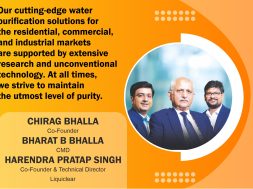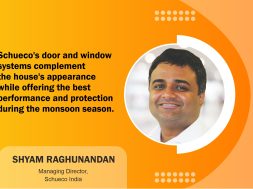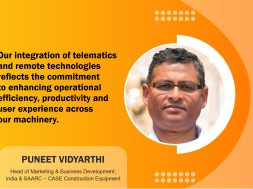All our projects qualify a minimum recommendation in form of energy and water usage

Our primary objective has been to optimise on three major areas, electrical, air-conditioning heating and ventilation (HVAC) and water consumption in the building says Sandip De, General Manager Design and Build, Shapoorji & Pallonji Engineering and Construction.
What measures do you take to ensure optimum energy efficiency in the projects undertaken?
In all our project we qualify a minimum recommendation in form of energy and water usage which can very well be related to a LEED standard Gold rating. In cases where there is a definite mandate from the client, we provide top notch solutions in terms of environment friendly solutions.
Our primary objective has been to optimise on three major areas, electrical, air-conditioning heating and ventilation (HVAC) and water consumption in the building. Our next focus is controlling the air conditioning load of the built form through effective planning and design.
The air circulation and ventilation of areas are designed through pragmatic natural solutions especially in the academic or residential projects. The architect plays a critical role in carefully laying down the master plan considering the wind rose and internal air flow pattern of the interior spaces or spaces between the buildings. The artificial cooling solutions are taken up based on agreed thermal index and available newer technologies in the market e.g. water-cooled chillers, radiant cooling, hybrid system etc. Apart from judicious distribution of the heat load, we give lot of importance on the envelope design specially glass parameters like the U value and shading coefficient etc. Rest of the approach depends on sensors and variable frequency drives, heat recovery wheels, VAVs to optimise the use of the equipment’s on regular basis. The landscape areas and the terraces are tiled with materials having high reflecting index so that minimum heat enters the building.
Another area of focus is water conservation. The buildings are designed as zero discharge element with the excess outflow from the final treatment plants being used as flushing or agriculture water and make up water for the cooling tower. The water balance diagram is created at the start of the concept layout and maintained till the end of the project. The fixtures selection is based on the flow parameters which enables us to reduce the water demand substantially.
How big is it a challenge to perpetuate energy efficiency post the completion of the project?
In most of our projects we handhold the client for the initial few years of building occupancy primarily to trouble shoot the operational aspects of the various equipment’s. Since all the critical equipment’s are controlled by a central building management system which acts as the central nervous system of the building, it becomes really convenient to control temperatures, humidity, levels, flow parameters etc. Further the upper and lower index working parameters are fed into the system which indicates the malfunctions or maintenance requirement of the equipment. Further, we always try to work out the final PUE (power utilization efficiency) which in most of the case matches with the one designed at the start of the project.
Can you cite the execution of a project which stood out owing to energy efficiency?
Intel Technology India Pvt Ltd recently completed construction of Intel’s Sarjapur Ring Road Building 3 (SRR3), a new office building in Bangalore, India. SRR3, located on an existing Intel campus with more than 3,500 Intel employees, is one of the most unique office buildings on an Intel site. This intelligent and efficient building which is now LEED Platinum certified for new construction was designed and built with the help of a small dedicated Intel team.
This 6,28,000-square-foot, nine-story office building is 48 per cent more energy efficient than other such buildings, produces 70 per cent less greenhouse gas (GHG) emissions and has the potential to save over 12 million gallons (MGY) of potable water annually.
Reliable power in India is a challenge. However, the frequent power shortages and interruptions led to new innovations. The energy management plan for SRR3 includes a “power saving” mode that controls the power usage pattern of the building. During a power outage, the building’s systems can switch to a lower energy demand by switching to a higher set point allowing the building to run for a longer period of time on backup power. Furthermore, metering, sensing and monitoring help facility managers better optimise building energy loads.
The SRR fuel cell technology installed in the project is the largest of its kind outside the U.S. and the first fuel cell system deployed for power generation in India. This technology converts natural gas into electricity without combustion and is integrated into the overall electricity generation mix, improving quality and reliability of electric supply to SRR3. The output of the fuel cell system is connected to the campus electric distribution network supplying power to SRR3 and has the capacity of displacing the building’s electricity usage and reducing CO2 emissions by more than 60 per cent.
Renewable solar thermal heat hybrid system installed on two rooftops is the source of hot water for the building. Integration of solar and other renewable energy technologies, including the solar light poles, has the potential to generate up to 13 per cent of the building’s electricity demand and contributes to significant cost savings. Approximately 10,000 sensors track and optimise temperature, lighting and energy consumption. Seventy per cent of the sensors located in the building’s digital ceiling provide 24/7 real-time data. This data is collected and analysed, helping facility managers improve building performance and conserve resources.
Intel achieved a smaller energy footprint by implementing a smart LED lighting solution that uses power over the Ethernet. Intelligent sensors drive down lighting power intensity to .39 watts/square foot. This smart lighting system is one of the many different types of smart technologies included in the building’s design and construction. Helping to optimise energy use, the smart building’s system connected with the conference room scheduling software can adjust lighting and temperature eight minutes before a meeting.
Data provided by the digital ceiling allows employees to view conference room and workstation availability as well as information on café occupancy. The data gathered from the smart ceiling provides insight into actual usage rates of the conference rooms and training rooms, helping to optimise future designs. Lastly, we share building performance with employees and visitors. This data is displayed on a large video wall located near the entrance.
Our water conservation and reuse strategies will result in potable water savings of approximately 12 MGY annually. In this water stressed area, Intel achieved water savings by focusing on technology improvements, including capturing condensate, rainwater harvesting and installing low flow fixtures throughout the building. The rain water is used in the cooling towers to offset water from the local municipality. Intel also invested in onsite wastewater treatment, which can be re-used in the restrooms and for landscape irrigation. Additionally, in the evenings the water cooled chillers are switched off, air chillers come on and set points for the building temperature are raised, resulting in further savings of water and energy.
What according to you would be the focus areas and energy efficiency trends in the upcoming decade?
The focus will be primarily on the renewable energy sources in the next decade. We have been already trying to harness solar, wind and to some extent geothermal but dependency aspect still remains a question. We need more sources which are clean and efficient. We need more and more technology in powering the equipment’s which increases the coefficient of performance to very high standards. We still need lot of judicious decision in controlling wastage especially in distribution of heat loads through energy modelling and consumption of power and water in daily use. Gradually we need to move to low embodied materials in all our elements of construction to reduce the energy demand of the factories where they are built.
12
Cookie Consent
We use cookies to personalize your experience. By continuing to visit this website you agree to our Terms & Conditions, Privacy Policy and Cookie Policy.









